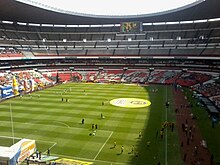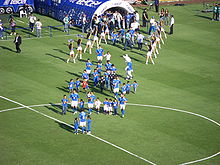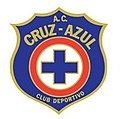CD Cruz Azul
| Cruz Azul | |||

|
|||
| Basic data | |||
|---|---|---|---|
| Surname | Club Deportivo Social y Cultural Cruz Azul AC |
||
| Seat | Mexico city | ||
| founding | March 22, 1927 | ||
| Colours | Blue White | ||
| president | Guillermo Álvarez Cuevas | ||
| Website | cruz-azul.com.mx | ||
| First soccer team | |||
| Head coach | Robert Siboldi | ||
| Venue | Estadio Azteca | ||
| Places | 87,000 | ||
| league | League MX | ||
| Clausura 2019 | Quarter finals | ||
|
|
|||



The Club Deportivo Social y Cultural Cruz Azul , or Deportivo Cruz Azul or shortly Cruz Azul is a Mexican football club , which since the 1971-72 season in Mexico City is located. Cruz Azul plays in the Primera División de México and played the home games until 2018 at the Estadio Azul , which is not far south of the city center. The team moved there in 1996 after playing for many years from 1971 in the Estadio Azteca in the Coyoacán district, which is much further south . From the 2018/19 season, Cruz Azul will return to the Estadio Azteca, as the lease for the Estadio Azul expires in late May 2018 and the stadium is being demolished. In the future, the club plans to play in its own stadium with 40,000 to 50,000 seats.
history
The association was founded on March 22, 1927 by workers from the cement factory "La Cruz Azul SA" in the city of Jasso , Hidalgo . Guillermo Álvarez Macías and Carlos Garcés were the main initiators of the founding and rapid, early successes of the club, which often represented the state of Hidalgo in national amateur tournaments.
From 1927 to 1960 the amateur team often played in Mexico City against the reserve teams of such renowned clubs as Club América , Necaxa , CF Atlante , Asturias and Marte . Under the impression of the team's increasing success, the management of the cement company (which later changed its name to "Cooperativa Cruz Azul") decided in 1960 to build a new stadium in Jasso, the Estadio 10 de diciembre , and the team for the season Officially registered in the second division in 1960/61.
In 1964, the team under the Hungarian coach Jorge Marik won the second division championship , which entitled to promotion to the highest Mexican league, the Primera División . The squad of the promotion team consisted of the following players: Aurelio Calvillo, Enríque Hernández, Enríque López, Félix Cárdenas, Fernando Bustos , Gabriel López, Héctor Pulido , Ismael Velázquez, Jaime Lomeli, Jesús García, José Guadalupe Gutiaz, Luis Bejaelupe Padilla, Ramón Ibarra, Raúl Arellano , Roberto Muciño, Roberto Reynoso, Regelio Alba.
In the first season they finished eighth, which gave rise to hopes for the future. Just four years later, Cruz Azul became Mexican champions for the first time under Raúl Cárdenas .
Cruz Azul became the most successful Mexican team of the 1970s, was national champion six times, four times under Raúl Cárdenas and twice under Ignacio Trelles . Because of this dominance, the team was referred to as "La Máquina" (the locomotive), a nickname that it still carries today.
1997 brought the team their eighth and so far last championship win under the coach Luis Fernando Tena .
2001
In 2001 Cruz Azul was invited to a tournament of Mexican and Venezuelan teams. The two best teams in this tournament were given the right to participate in the Copa Libertadores , the competition for the best South American club teams. Cruz Azul not only qualified in the first attempt, but also made it to the final after knocking out well-known Brazilian and Argentine teams such as AD São Caetano , Rosario Central and River Plate . In the final they met the Argentine club Boca Juniors . They lost the first leg at home with 0: 1, but they won the second leg away with the same result. It was the first time Boca Juniors lost a Copa Libertadores final at home. After extra time failed to score, a penalty shoot-out was the deciding factor in which the more experienced Boca Juniors players had the upper hand. Cruz Azul, however, remained the big surprise of the year in this competition, as one had advanced to the final right from the first participation. The coach at the time was José Luis Trejo , who became Mexican champion in 2006 with Club CF Pachuca.
2005
On July 19, 2005, the Argentinian trainer Rubén Omar Romano was kidnapped after training. He was only released two months later by a police operation. Seven suspected kidnappers were arrested.
Historical logos
title
- Mexican league champions: 8
- Runner-up: 6
- 1969/70, 1980/81, 1986/87, 1988/89, 1994/95, Verano 1999
-
Copa México : 3rd
- 1969 , 1997, Clausura 2013
-
Campeón de Campeones : 2
- 1969, 1974
- Copa Libertadores finalist: 1
-
CONCACAF Champions Cup : 5th
- 1969, 1970, 1971, 1996, 1997
-
CONCACAF Champions League : 1
- 2014
The "best team of all time"
The Mexican sports newspaper Récord has identified the following "dream team" of the CD Cruz Azul with the most important players in the history of the Cementeros (the years in brackets describe the club membership):
Miguel Marín (1971–1980) - Ignacio Flores (1972–1990), Alberto Quintano (1971–1977), Javier Guzmán (1967–1978), Javier Sánchez Galindo (1966–1974) - Carlos Jara Saguier (1975–1983), Guillermo Mendizábal (1974–1982), Fernando Bustos (1963–1976) - Francisco Palencia (1989–2001), Carlos Hermosillo (1991–1998), Eladio Vera (1971–1977).
player
-

 Mauro Camoranesi (1998-2000)
Mauro Camoranesi (1998-2000) -
 Óscar Pérez Rojas (1998-2008)
Óscar Pérez Rojas (1998-2008) -
 Aarón Galindo (2002-2006)
Aarón Galindo (2002-2006) -
 Ricardo Osorio (2002-2006)
Ricardo Osorio (2002-2006) -
 César Delgado (2003-2007)
César Delgado (2003-2007) -
 Francisco Fonseca (2005-2006)
Francisco Fonseca (2005-2006) -
 Gerardo Torrado (2005-)
Gerardo Torrado (2005-)
See also
Fans
Cruz Azul currently has twelve official fan clubs, of which the Ultrà group La Sangre Azul is likely to be the most important.
The well-known fans of the Cementeros include:
- Marco Antonio Barrera , boxer
- Eugenio Derbez , actor
- Martha Higareda , actress, screenwriter and producer
- Claudia Lizaldi , news anchor, actress and model
- Emmanuel Del Real, piano player from Café Tacuba
Web links
- official page
- FIFA.com: A cinematic story
Individual evidence
- ↑ stadiumdb.com: Mexico City: Cruz Azul to relocate to Azteca article from April 23, 2017 (English)
- ↑ stadiumdb.com: Mexico City: Cruz Azul aiming for 40,000–50,000 stadium article from January 12, 2017 (English)
- ↑ La Historia Azul: 40 años en Primera división (1964-2004) , p. 14
- ↑ Récord: Te presentamos el 11 ideal histórico del Cruz Azul (Spanish; article from August 17, 2012)
- ↑ Duelo de celebridades por Cruz Azul y América: los hinchas famosos del Clásico Joven (Spanish; accessed on August 6, 2018)

